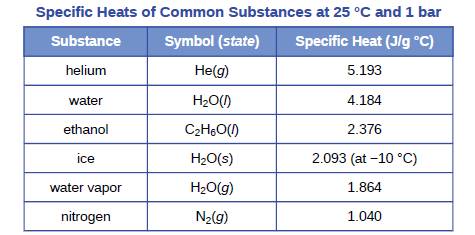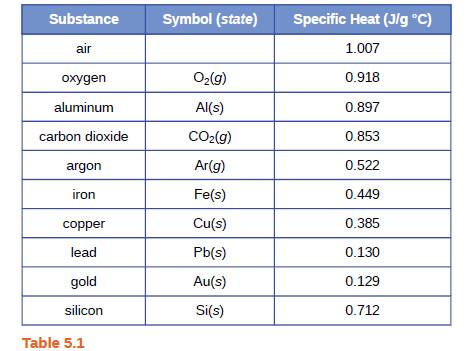
CHEMISTRY
2nd Edition
ISBN: 9781593995782
Author: OpenStax
Publisher: XANEDU PUBLISHING
expand_more
expand_more
format_list_bulleted
Textbook Question
Chapter 5, Problem 10E
A piece of unknown substance weighs 44.7 g and requires 2110 J to increase its temperature from 23.2 °C to 89.6 °C.
(a) What is the specific heat of the substance?
(b) If it is one of the substances found in Table 5.1, what is its likely identity?


Expert Solution & Answer
Trending nowThis is a popular solution!

Students have asked these similar questions
What is the molecular orbital for cyclopropenyl anion and is it aromatic, antiaromatic or nonaromatic?
Using the chart describe the change from cystine to tyrosine and its impact on the protein.
Using the chart describe the change from histidine to aspartic acid and its impact on the protein.
How to get the predicted product of this reaction below
Chapter 5 Solutions
CHEMISTRY
Ch. 5 - A burning match and a bonfire may have the same...Ch. 5 - Prepare a table identifying several energy...Ch. 5 - Explain the difference between heat capacity and...Ch. 5 - Calculate the heat capacity, in joules and in...Ch. 5 - Calculate the heat capacity, in joules and in...Ch. 5 - How much heat, in joules and in calories, must be...Ch. 5 - How much heat, in joules and in calories, is...Ch. 5 - How much would the temperature of 275 g of water...Ch. 5 - If 14.5 kJ of heat were added to 485 g of liquid...Ch. 5 - A piece of unknown substance weighs 44.7 g and...
Ch. 5 - A piece of unknown solid substance weighs 437.2 g,...Ch. 5 - An aluminum kettle weighs 1.05 kg. (a) What is the...Ch. 5 - Most people find waterbeds uncomfortable unless...Ch. 5 - A 500-mL bottle of water at room temperature and a...Ch. 5 - Would the amount of heat measured for the reaction...Ch. 5 - Would the amount of heat absorbed by the...Ch. 5 - Would the amount of heat absorbed by the...Ch. 5 - How many milliliters of water at 23 C with a...Ch. 5 - How much will the temperature of a cup (180 g) of...Ch. 5 - A 45-g aluminum spoon (specific heat 0.88 J/g C)...Ch. 5 - The temperature of the cooling water as it leaves...Ch. 5 - A 70.0-g piece of metal at 80.0 °C is placed in...Ch. 5 - If a reaction produces 1.506 kJ of heat, which is...Ch. 5 - A 0.500-g sample of KCl is added to 50.0 g of...Ch. 5 - Dissolving 3.0 g of CaCl2(s) in 150.0 g of water...Ch. 5 - When 50.0 g of 0.200 M NaCl(aq) at 24.1 C is added...Ch. 5 - The addition of 3.15 g of Ba(OH)28H2O to a...Ch. 5 - The reaction of 50 mL of acid and 50 mL of base...Ch. 5 - If the 3.21 g of NH4NO3 in Example 5.6 were...Ch. 5 - When 1.0 g of fructose, C6H12O6(s), a sugar...Ch. 5 - When a 0.740-g sample of trinitrotoluene (TNT),...Ch. 5 - One method of generating electricity is by burning...Ch. 5 - The amount of fat recommended for someone with a...Ch. 5 - A teaspoon of the carbohydrate sucrose (common...Ch. 5 - What is the maximum mass of carbohydrate in a 6-oz...Ch. 5 - A pint of premium ice cream can contain 1100...Ch. 5 - A serving of a breakfast cereal contains 3 g of...Ch. 5 - Which is the least expensive source of energy in...Ch. 5 - Explain how the heat measured in Example 5.5...Ch. 5 - Using the data in the check your learning section...Ch. 5 - Calculate the enthalpy of solution ( H for the...Ch. 5 - Calculate H for the reaction described by the...Ch. 5 - Calculate the enthalpy of solution ( H for the...Ch. 5 - Although the gas used in an oxyacetylene torch...Ch. 5 - How much heat is produced by burning 4.00 moles of...Ch. 5 - How much heat is produced by combustion of 125 g...Ch. 5 - How many moles of isooctane must be burned to...Ch. 5 - What mass of carbon monoxide must be burned to...Ch. 5 - When 2.50 g of methane burns in oxygen, 125 kJ of...Ch. 5 - How much heat is produced when loo mL of 0.250 M...Ch. 5 - A sample of 0.562 g of carbon is burned in oxygen...Ch. 5 - Before the introduction of chlorofluorocarbons,...Ch. 5 - Homes may be heated by pumping hot water through...Ch. 5 - Which of the enthalpies of combustion in Table 5.2...Ch. 5 - Does the standard enthalpy of formation of H2O(g)...Ch. 5 - Joseph Priestly prepared oxygen in 1774 by heating...Ch. 5 - How many kilojoules of heat will be released when...Ch. 5 - How many kilojoules of heat will be released when...Ch. 5 - The following sequence of reactions occurs in the...Ch. 5 - Both graphite and diamond burn....Ch. 5 - From the molar heats of formation in Appendix G,...Ch. 5 - Which produces more heat?...Ch. 5 - Calculate H298 for the process...Ch. 5 - Calculate H298 for the process...Ch. 5 - Calculate H for the process Hg2Cl2(s)2Hg(l)+Cl2(g)...Ch. 5 - Calculate H298 for the process...Ch. 5 - Calculate the standard molar enthalpy of formation...Ch. 5 - Using the data in Appendix G, calculate the...Ch. 5 - Using the data in Appendix G, calculate the...Ch. 5 - The following reactions can be used to prepare...Ch. 5 - The decomposition of hydrogen peroxide, H2O2, has...Ch. 5 - Calculate the enthalpy of combustion of propane,...Ch. 5 - Calculate the enthalpy of combustion of butane,...Ch. 5 - Both propane and butane are used as gaseous fuels....Ch. 5 - The white pigment TiO2 is prepared by the reaction...Ch. 5 - Water gas, a mixture of H2 and CO, is an important...Ch. 5 - In the early days of automobiles, illumination at...Ch. 5 - From the data in Table 5.2, determine which of the...Ch. 5 - The enthalpy of combustion of hard coal averages...Ch. 5 - Ethanol, C2H5OH, is used as a fuel for motor...Ch. 5 - Among the substances that react with oxygen and...Ch. 5 - How much heat is produced when 1.25 g of chromium...Ch. 5 - Ethylene, C2H2, a byproduct from the fractional...Ch. 5 - The oxidation of the sugar glucose, C6H12O6, is...Ch. 5 - Propane, C3H8, is a hydrocarbon that is commonly...Ch. 5 - During a recent winter month in Sheboygan,...
Additional Science Textbook Solutions
Find more solutions based on key concepts
Which of the following statements about the general functions of the nervous system is false?
The three primary...
Human Anatomy & Physiology (2nd Edition)
What two components contribute to species diversity? Explain how two communities with the same number of specie...
Campbell Biology (11th Edition)
Match the following examples of mutagens. Column A Column B ___a. A mutagen that is incorporated into DNA in pl...
Microbiology: An Introduction
29. Consider the unbalanced equation for the reaction of solid lead with silver nitrate:
a. Balance the equati...
Introductory Chemistry (6th Edition)
Distinguish between microevolution, speciation, and macroevolution.
Campbell Essential Biology (7th Edition)
17. Anthropologists are interested in locating areas in Africa where fossils 4-8 million years old might be fou...
Campbell Biology: Concepts & Connections (9th Edition)
Knowledge Booster
Learn more about
Need a deep-dive on the concept behind this application? Look no further. Learn more about this topic, chemistry and related others by exploring similar questions and additional content below.Similar questions
- Please help me fill out the chart then using the chart describe the change from cystine to tyrosine and its impact on the protein. Then using the chart describe the change from histidine to aspartic acid.arrow_forwardWrite the Esterification reaction mechanism for acetic acid, and one propanol to make propanol ethanoate (molecule that gives peas its odor in flavor)arrow_forwardProvide solutionsarrow_forward
- Which of these compounds is Ester formed from the reaction of acetic acid and one propanol arrow_forwardDescribe the four labeled parts of the reaction diagram from the reaction of sucrose, breaking down with and without an enzyme.arrow_forwardHow to determine the product with mechanism showedarrow_forward
arrow_back_ios
SEE MORE QUESTIONS
arrow_forward_ios
Recommended textbooks for you
 General Chemistry - Standalone book (MindTap Cour...ChemistryISBN:9781305580343Author:Steven D. Gammon, Ebbing, Darrell Ebbing, Steven D., Darrell; Gammon, Darrell Ebbing; Steven D. Gammon, Darrell D.; Gammon, Ebbing; Steven D. Gammon; DarrellPublisher:Cengage Learning
General Chemistry - Standalone book (MindTap Cour...ChemistryISBN:9781305580343Author:Steven D. Gammon, Ebbing, Darrell Ebbing, Steven D., Darrell; Gammon, Darrell Ebbing; Steven D. Gammon, Darrell D.; Gammon, Ebbing; Steven D. Gammon; DarrellPublisher:Cengage Learning Chemistry: Principles and ReactionsChemistryISBN:9781305079373Author:William L. Masterton, Cecile N. HurleyPublisher:Cengage Learning
Chemistry: Principles and ReactionsChemistryISBN:9781305079373Author:William L. Masterton, Cecile N. HurleyPublisher:Cengage Learning Chemistry: The Molecular ScienceChemistryISBN:9781285199047Author:John W. Moore, Conrad L. StanitskiPublisher:Cengage Learning
Chemistry: The Molecular ScienceChemistryISBN:9781285199047Author:John W. Moore, Conrad L. StanitskiPublisher:Cengage Learning Chemistry by OpenStax (2015-05-04)ChemistryISBN:9781938168390Author:Klaus Theopold, Richard H Langley, Paul Flowers, William R. Robinson, Mark BlaserPublisher:OpenStax
Chemistry by OpenStax (2015-05-04)ChemistryISBN:9781938168390Author:Klaus Theopold, Richard H Langley, Paul Flowers, William R. Robinson, Mark BlaserPublisher:OpenStax Chemistry: Principles and PracticeChemistryISBN:9780534420123Author:Daniel L. Reger, Scott R. Goode, David W. Ball, Edward MercerPublisher:Cengage LearningChemistry: Matter and ChangeChemistryISBN:9780078746376Author:Dinah Zike, Laurel Dingrando, Nicholas Hainen, Cheryl WistromPublisher:Glencoe/McGraw-Hill School Pub Co
Chemistry: Principles and PracticeChemistryISBN:9780534420123Author:Daniel L. Reger, Scott R. Goode, David W. Ball, Edward MercerPublisher:Cengage LearningChemistry: Matter and ChangeChemistryISBN:9780078746376Author:Dinah Zike, Laurel Dingrando, Nicholas Hainen, Cheryl WistromPublisher:Glencoe/McGraw-Hill School Pub Co

General Chemistry - Standalone book (MindTap Cour...
Chemistry
ISBN:9781305580343
Author:Steven D. Gammon, Ebbing, Darrell Ebbing, Steven D., Darrell; Gammon, Darrell Ebbing; Steven D. Gammon, Darrell D.; Gammon, Ebbing; Steven D. Gammon; Darrell
Publisher:Cengage Learning

Chemistry: Principles and Reactions
Chemistry
ISBN:9781305079373
Author:William L. Masterton, Cecile N. Hurley
Publisher:Cengage Learning

Chemistry: The Molecular Science
Chemistry
ISBN:9781285199047
Author:John W. Moore, Conrad L. Stanitski
Publisher:Cengage Learning

Chemistry by OpenStax (2015-05-04)
Chemistry
ISBN:9781938168390
Author:Klaus Theopold, Richard H Langley, Paul Flowers, William R. Robinson, Mark Blaser
Publisher:OpenStax

Chemistry: Principles and Practice
Chemistry
ISBN:9780534420123
Author:Daniel L. Reger, Scott R. Goode, David W. Ball, Edward Mercer
Publisher:Cengage Learning

Chemistry: Matter and Change
Chemistry
ISBN:9780078746376
Author:Dinah Zike, Laurel Dingrando, Nicholas Hainen, Cheryl Wistrom
Publisher:Glencoe/McGraw-Hill School Pub Co
The Laws of Thermodynamics, Entropy, and Gibbs Free Energy; Author: Professor Dave Explains;https://www.youtube.com/watch?v=8N1BxHgsoOw;License: Standard YouTube License, CC-BY